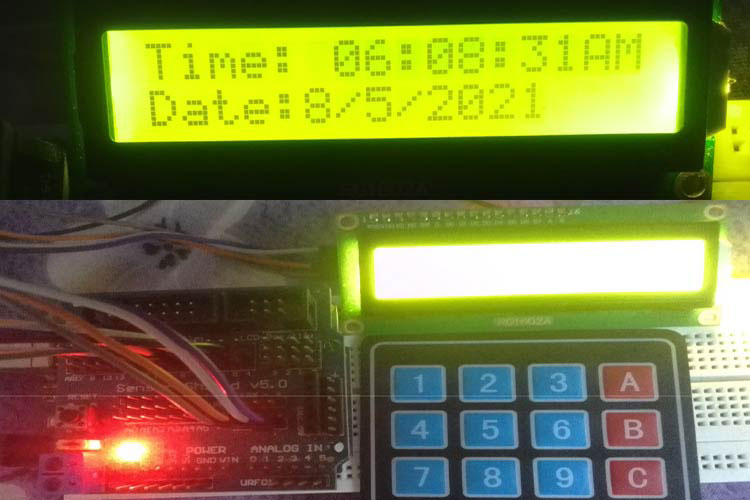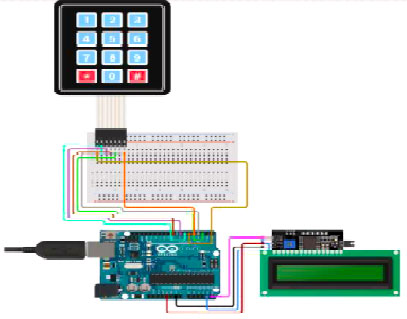
In this project, we have the above mentioned components and the working is quite east to understand .The input will be taken from the user through the matrix keypad. At first we have to give The Hour and then minutes. Then we have to insert Date and month and year format. The AM and PM format will be automatically set on the basis of 24 hours configuration. I2C module is connected with Arduino sensor shield through TX(0) and RX(1) pin with SDA and SCL pins. Here, different I2C Library functions are used to make project understand a little bit easier. The matrix keypad has 8 pins connected with Arduino UNO sensor shield. After entering the date ,month, hour, minute and second the data will be displayed on the LCD display. The Arduino Uno is a microcontroller board based on the ATmega328. It has 20 digital input/output pins (of which 6 can be used as PWM outputs and 6 can be used as analog inputs), a 16 MHz resonator, a USB connection, a power jack, an in-circuit system programming (ICSP) header, and a reset button. A matrix keypad is a small compact input device that accepts user inputs and processed by Microcontrollers. You might have seen this in most commonly used devices like Calculators, Digital locks, Gas pumps and DIY projects. It comes in different types, one of them is membrane keypads, it is thinner in size and you can paste it on top of your creative projects.16×2 LCD is one kind of electronic device used to display the message and data. The term LCD full form is Liquid Crystal Display. The display has 16 Columns and 2 Rows. it can be displayed 32 characters in total and each character will be made of 5×8 Pixel Dots. These displays are mainly based on multi-segment light-emitting diodes. The 16×2 LCD is widely used. These LCD modules are low cost, and programmer-friendly, therefore, is used in various DIY circuits, devices, and embedded projects.Arduino shields are the boards, which are plugged over the Arduino board to expand its functionalities. There are different varieties of shields used for various tasks, such as Arduino motor shields, Arduino communication shields, etc. I2C Module has a inbuilt PCF8574 I2C chip that converts I2C serial data to parallel data for the LCD display. These modules are currently supplied with a default I2C address of either 0x27 or 0x3F. To determine which version you have check the black I2C adaptor board on the underside of the module. If there a 3 sets of pads labelled A0, A1, & A2 then the default address will be 0x3F. If there are no pads the default address will be 0x27.
Required Components
Project Used Hardware
- Arduino UNO module
- LCD Display module
- Keypad
- Breadboard and wires
Project Used Software
- Arduino IDE
Project Hardware Software Selection
The Arduino Uno is a microcontroller board based on the ATmega328. It has 20 digital input/output pins (of which 6 can be used as PWM outputs and 6 can be used as analog inputs), a 16 MHz resonator, a USB connection, a power jack, an in-circuit system programming (ICSP) header, and a reset button. A matrix keypad is a small compact input device that accepts user inputs and processed by Microcontrollers. You might have seen this in most commonly used devices like Calculators, Digital locks, Gas pumps and DIY projects. It comes in different types, one of them is membrane keypads, it is thinner in size and you can paste it on top of your creative projects.16×2 LCD is one kind of electronic device used to display the message and data. The term LCD full form is Liquid Crystal Display. The display has 16 Columns and 2 Rows. it can be displayed 32 characters in total and each character will be made of 5×8 Pixel Dots. These displays are mainly based on multi-segment light-emitting diodes. The 16×2 LCD is widely used. These LCD modules are low cost, and programmer-friendly, therefore, is used in various DIY circuits, devices, and embedded projects.Arduino shields are the boards, which are plugged over the Arduino board to expand its functionalities. There are different varieties of shields used for various tasks, such as Arduino motor shields, Arduino communication shields, etc.I2C Module has a inbuilt PCF8574 I2C chip that converts I2C serial data to parallel data for the LCD display. These modules are currently supplied with a default I2C address of either 0x27 or 0x3F. To determine which version you have check the black I2C adaptor board on the underside of the module. If there a 3 sets of pads labelled A0, A1, & A2 then the default address will be 0x3F. If there are no pads the default address will be 0x27.
Circuit Diagram
Also check our previous digital clock projects:
Complete Project Code
#include <Wire.h>
#include <LiquidCrystal_I2C.h>
#include<Keypad.h>
int clock(int hr,int minute,int sec);
int date(int hr,int minute,int sec);
int i,j,k,hr1,minute1,sec1;
int flag=0;
// Set the LCD address to 0x27 for a 16 chars and 2 line display
LiquidCrystal_I2C lcd(0x3F, 16, 2);
const byte ROWS = 4; //four rows
const byte COLS = 4; //three columns
char keys[ROWS][COLS] = {
{'1','2','3','A'},
{'4','5','6','B'},
{'7','8','9','C'},
{'*','0','#','D'}
};
byte rowPins[ROWS] = {11, 10, 9, 8}; //connect to the row pinouts of the keypad
byte colPins[COLS] = {7, 6, 5, 4}; //connect to the column pinouts of the keypad
Keypad keypad = Keypad( makeKeymap(keys), rowPins, colPins, ROWS, COLS );
void setup()
{
lcd.begin();
lcd.backlight();
Serial.begin(9600);
lcd.setCursor(0,0);
lcd.print("WELCOME,");
lcd.setCursor(0,1);
lcd.print("To Digital Clock");
delay(2000);
lcd.clear();
delay(1100);
}
void loop(){
if(flag==0){
hr1=sethour();
minute1=setmin();
sec1=00;}
}
clock(hr1,minute1,sec1);
}
int sethour() //for setting the hour format
{
lcd.setCursor(0,0);
lcd.print("Press # To");
lcd.setCursor(0,1);
lcd.print("Set HOUR:");
int val1= getKeypadIntegerMulti();
Serial.println("Value is");
Serial.println(val1);
delay(500);
lcd.clear();
delay(500);
return val1;
}
int setmin() //for setting the minute format
{
lcd.setCursor(0,0);
lcd.print("Press # To");
lcd.setCursor(0,1);
lcd.print("Set MINUTE:");
int val2= getKeypadIntegerMulti();
Serial.println("Value is");
Serial.println(val2);
delay(500);
lcd.clear();
delay(500);
return val2;
}
long getKeypadIntegerMulti()
{
long value = 0; // the number accumulator
long keyvalue; // the key pressed at current moment
int isnum;
Serial.println("Enter the digits ");
Serial.print("You have typed: ");
do
{
keyvalue = keypad.getKey(); // input the key
isnum = (keyvalue >= '0' && keyvalue <= '9'); // is it a digit?
if (isnum)
{
Serial.print(keyvalue - '0');
lcd.print(keyvalue - '0');
value = value * 10 + keyvalue - '0'; // accumulate the input number
}
} while (isnum || !keyvalue); // until not a digit or while no key pressed
//
Serial.println(" ");
Serial.print("Returning from funtion: ");
Serial.println(value);
return value;
}//getKeypadInteger
int clock(int hr,int minute,int sec)
{
if(hr==0 || minute<60 && sec==0 || sec<60)
{
// i loop for day hour
for(i=hr;i<24;i++)
{
// j loop for day mins
for(j=minute;j<60;j++)
{
//k loop for day seconds
for(k=sec;k<60;k++)
{
lcd.print("Time: ");
if(i<=9){ // for hour setting if 0 to 9 then set 0 in front of them like 01,02,03 etc.
lcd.print("0");
}
lcd.print(i,DEC);
lcd.print(":");
if(j<=9){
lcd.print("0");
}
lcd.print(j,DEC);
lcd.print(":");
if(i<12)
{
if(k<=9)
{
lcd.print("0");
}
lcd.print(k);
lcd.print("AM");
}
else
{
if(k<=9)
{
lcd.print("0");
}
lcd.print(k);
lcd.print("PM");
}
delay(100);
lcd.clear();
}
sec=0;
minute=0;
lcd.clear();
}
}
}
lcd.clear();
hr=0;
minute=0;
sec=0;
flag=1;
}






